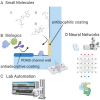Application of lung microphysiological systems to COVID-19 modeling and drug discovery: a review
- PMID: 34178414
- PMCID: PMC8213042
- DOI: 10.1007/s42242-021-00136-5
Application of lung microphysiological systems to COVID-19 modeling and drug discovery: a review
Abstract
There is a pressing need for effective therapeutics for coronavirus disease 2019 (COVID-19), the respiratory disease caused by severe acute respiratory syndrome coronavirus 2 (SARS-CoV-2) virus. The process of drug development is a costly and meticulously paced process, where progress is often hindered by the failure of initially promising leads. To aid this challenge, in vitro human microphysiological systems need to be refined and adapted for mechanistic studies and drug screening, thereby saving valuable time and resources during a pandemic crisis. The SARS-CoV-2 virus attacks the lung, an organ where the unique three-dimensional (3D) structure of its functional units is critical for proper respiratory function. The in vitro lung models essentially recapitulate the distinct tissue structure and the dynamic mechanical and biological interactions between different cell types. Current model systems include Transwell, organoid and organ-on-a-chip or microphysiological systems (MPSs). We review models that have direct relevance toward modeling the pathology of COVID-19, including the processes of inflammation, edema, coagulation, as well as lung immune function. We also consider the practical issues that may influence the design and fabrication of MPS. The role of lung MPS is addressed in the context of multi-organ models, and it is discussed how high-throughput screening and artificial intelligence can be integrated with lung MPS to accelerate drug development for COVID-19 and other infectious diseases.
Keywords: Bioengineering; COVID-19; Drug development; Lung; Microfluidics; Microvascular networks; Organ-on-a-chip.
© The Author(s) 2021.
Conflict of interest statement
Conflict of interestAMS is cofounder of Eidolon Hydros, a startup specializing in cell culture substrates for microphysiological systems and drug delivery.
Figures




Similar articles
-
Engineering organ-on-a-chip systems to model viral infections.Biofabrication. 2023 Feb 6;15(2):10.1088/1758-5090/ac6538. doi: 10.1088/1758-5090/ac6538. Biofabrication. 2023. PMID: 35390777 Free PMC article. Review.
-
Microfluidic Organs-on-a-Chip for Modeling Human Infectious Diseases.Acc Chem Res. 2021 Sep 21;54(18):3550-3562. doi: 10.1021/acs.accounts.1c00411. Epub 2021 Aug 29. Acc Chem Res. 2021. PMID: 34459199
-
Harnessing the power of microphysiological systems for COVID-19 research.Drug Discov Today. 2021 Nov;26(11):2496-2501. doi: 10.1016/j.drudis.2021.06.020. Epub 2021 Jul 28. Drug Discov Today. 2021. PMID: 34332095 Free PMC article.
-
Fitting tissue chips and microphysiological systems into the grand scheme of medicine, biology, pharmacology, and toxicology.Exp Biol Med (Maywood). 2017 Oct;242(16):1559-1572. doi: 10.1177/1535370217732765. Exp Biol Med (Maywood). 2017. PMID: 29065799 Free PMC article.
-
Organs-on-a-Chip.Adv Exp Med Biol. 2020;1230:27-42. doi: 10.1007/978-3-030-36588-2_3. Adv Exp Med Biol. 2020. PMID: 32285363 Review.
Cited by
-
Advanced Microfluidic Vascularized Tissues as Platform for the Study of Human Diseases and Drug Development.Curr Neuropharmacol. 2023;21(3):599-620. doi: 10.2174/1570159X20666220706112711. Curr Neuropharmacol. 2023. PMID: 35794768 Free PMC article.
-
An Immunocompetent Microphysiological System to Simultaneously Investigate Effects of Anti-Tumor Natural Killer Cells on Tumor and Cardiac Microtissues.Front Immunol. 2021 Dec 2;12:781337. doi: 10.3389/fimmu.2021.781337. eCollection 2021. Front Immunol. 2021. PMID: 34925361 Free PMC article.
-
Organ-on-chip technology: Opportunities and challenges.Biotechnol Notes. 2024 Jan 5;5:8-12. doi: 10.1016/j.biotno.2024.01.001. eCollection 2024. Biotechnol Notes. 2024. PMID: 39416695 Free PMC article. Review.
-
Engineering organ-on-a-chip systems to model viral infections.Biofabrication. 2023 Feb 6;15(2):10.1088/1758-5090/ac6538. doi: 10.1088/1758-5090/ac6538. Biofabrication. 2023. PMID: 35390777 Free PMC article. Review.
-
Multi-Organs-on-Chips for Testing Small-Molecule Drugs: Challenges and Perspectives.Pharmaceutics. 2021 Oct 11;13(10):1657. doi: 10.3390/pharmaceutics13101657. Pharmaceutics. 2021. PMID: 34683950 Free PMC article. Review.
References
Publication types
Grants and funding
LinkOut - more resources
Full Text Sources
Miscellaneous
